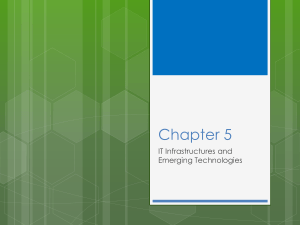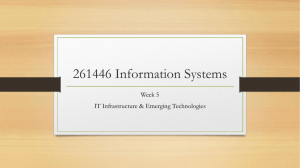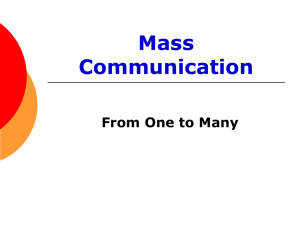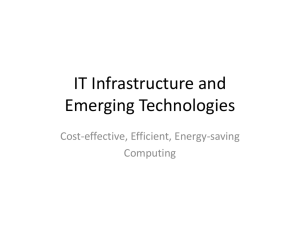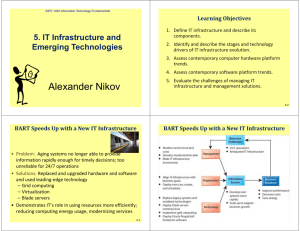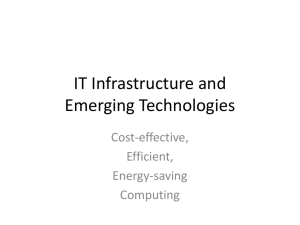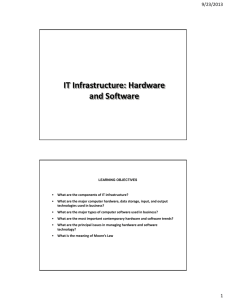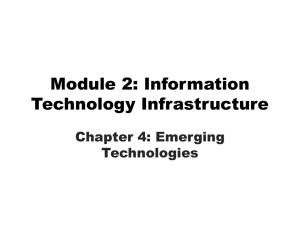chapter2
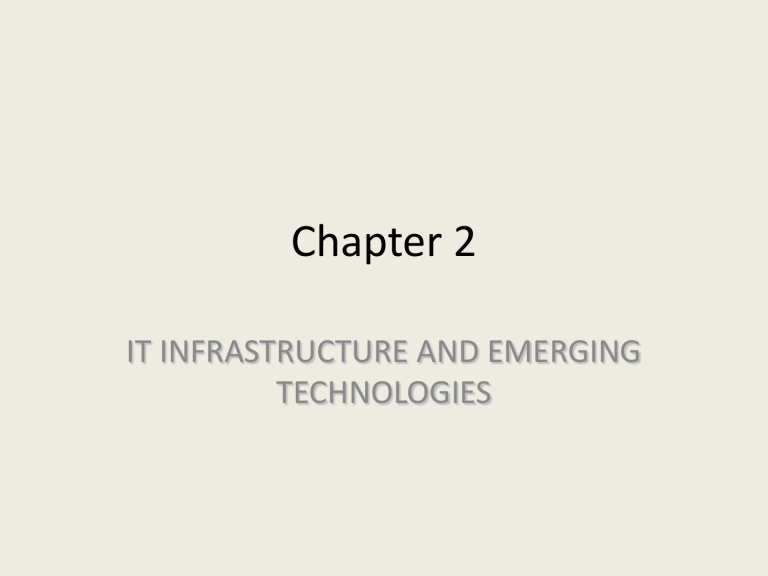
Chapter 2
IT INFRASTRUCTURE AND EMERGING
TECHNOLOGIES
IT Infrastructure
• Set of physical devices and software required to operate enterprise
– Computing platforms providing computing services
– Telecommunications services
– Data management services
– Application software services
– Physical facilities management services
– IT management, education, and other services
Evolution of IT infrastructure
– General-purpose mainframe and minicomputer era: 1959 to present
• IBM first mainframes(1958), DEC minicomputers(1965)
– Personal computer era: 1981 to present
• IBM PC(1981); growth of personal software(80s, 90s)
– Client/server era: 1983 to present
• Network may be two-tiered or multitiered (N-tiered); Various types of servers
(network, application, Web)
– Enterprise computing era: 1992 to present
• Integrating disparate networks, applications using Internet standards and enterprise applications
– Cloud and mobile computing: 2000 to present
• Computing power and software applications supplied over the Internet or other network
A MULTITIERED CLIENT/SERVER NETWORK (N-TIER)
Technology drivers of infrastructure evolution
1. Moore’s Law
• Law of microprocessing power
– Computing power doubles every 18 months
– Nanotechnology: Shrinks size of transistors to size comparable to size of a virus
• Law of Mass Digital Storage
– The amount of data being stored each year doubles
FALLING COST OF CHIPS and
STORING DATA
Technology drivers of infrastructure evolution
2. Metcalfe ’ s Law
• Network economics
– Value or power of a network grows exponentially as a function of the number of network members
– As network members increase, more people want to use it (demand for network access increases)
Declining communication costs and the Internet
• An estimated 2.3 billion people worldwide have Internet access
• As communication costs fall and approach 0, utilization of communication and computing facilities explodes
Technology drivers of infrastructure evolution
3. Standards and network effects
• Specifications that establish the compatibility of products and the ability to communicate in a network
1.
Computer hardware platforms
2.
Operating system platforms
3.
Enterprise software applications
4.
Data management and storage
5.
Networking/telecommunications platforms
6.
Internet platforms
7.
Consulting system integration services
• Unleash powerful economies of scale and result in price declines as manufacturers focus on the products built to a single standard
THE IT INFRASTRUCTURE ECOSYSTEM
Contemporary Hardware Platform Trends
• BYOD (Bring your own device)
– Allowing employees to use personal mobile devices in workplace
• Consumerization of IT
– New information technology emerges in consumer markets first and spreads to business organizations
– Forces businesses and IT departments to rethink how IT equipment and services are acquired and managed
• Grid computing
– Connects geographically remote computers into a single network to combine processing power and create virtual supercomputer
– Provides cost savings, speed, agility
• Virtualization
– Allows single physical resource to act as multiple resources (i.e., run multiple instances of OS)
– Reduces hardware and power expenditures
– Facilitates hardware centralization
Contemporary Hardware Platform Trends-cont’d
CLOUD COMPUTING PLATFORM
• Cloud computing: Ondemand (utility) computing services obtained over network
• Infrastructure as a service
• Platform as a service
• Software as a service
• Virtualized resources provided over the
Internet.
• Access to applications and IT infrastructure anywhere, at any time, and on any device.
Contemporary Hardware Platform Trends –cont’d
• Green computing
– Practices and technologies for manufacturing, using, disposing of computing and networking hardware
• Autonomic computing
– Industry-wide effort to develop systems that can configure, heal themselves when broken, and protect themselves from outside intruders
– Similar to self-updating antivirus software; Apple and Microsoft both use automatic updates
Contemporary Software Platform Trends
• Open-source software:
– Produced by community of programmers
– Free and modifiable by user
– Examples: Apache web server, Mozilla Firefox browser, OpenOffice,
Linux
• Software for the Web
– Java:
– HTML/HTML5
– XML
• Web Services
– Software components that exchange information using Web standards and languages
– Dollar Rent A Car uses Web services to link online booking system with
Southwest Airlines ’ Web site
HOW DOLLAR RENT A CAR USES WEB SERVICES
Contemporary Software Platform Trends-cont’d
• SOA: Service-oriented architecture
– Set of self-contained services that communicate with each other to create a working software application
– Software developers reuse these services in other combinations to assemble other applications as needed
• Example: an “ invoice service ” to serve whole firm for calculating and sending printed invoices
• Software outsourcing and cloud services
– Software packages and enterprise software
– Software outsourcing
• Contracting outside firms to develop software
– Cloud-based software services
• Software as a service (SaaS)
• Accessed with Web browser over Internet
• Service Level Agreements (SLAs): formal agreement with service providers
CHANGING SOURCES OF FIRM SOFTWARE
Contemporary Software Platform Trends
– Mashups
• Combinations of two or more online applications, such as combining mapping software (Google Maps) with local content
– Apps
• Small pieces of software that run on the Internet, on your computer, or on your cell phone
– iPhone, Android
• Generally delivered over the Internet
Management Issues
– As firms shrink or grow, IT needs to be flexible and scalable
– Amount to spend on IT is complex question
• Rent vs. buy, cloud computing, Outsourcing
– Total cost of ownership (TCO) model
• Analyzes direct and indirect costs
• Hardware, software account for only about 20% of TCO
• Other costs: Installation, training, support, maintenance, infrastructure, downtime, space, and energy

